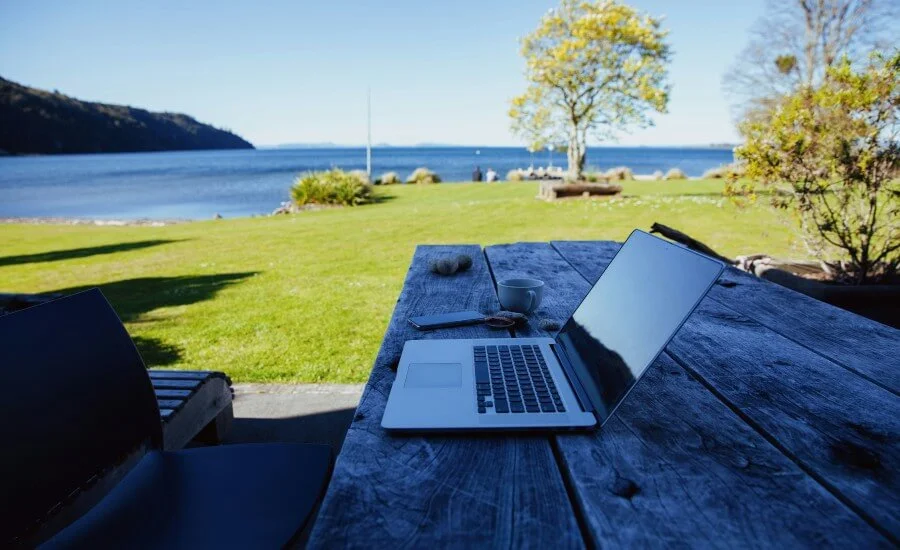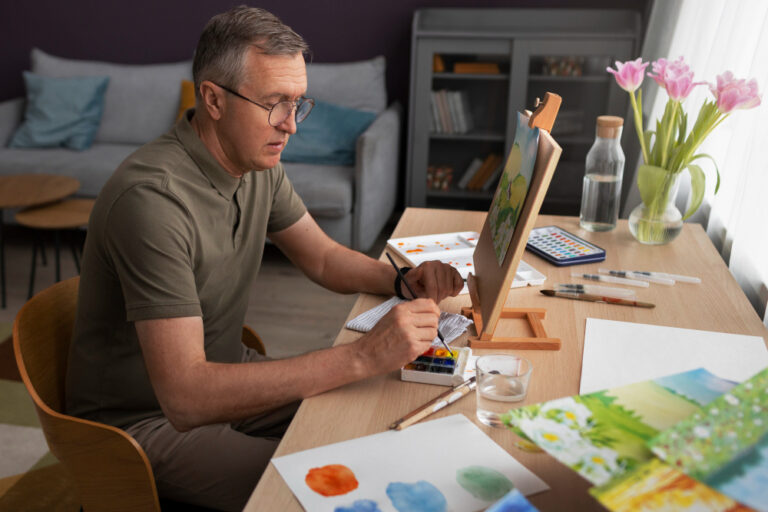
It’s the dream sold across countless Instagram feeds: working from a laptop on a tropical beach, exploring new cities every month, embracing ultimate freedom and adventure. The digital nomad lifestyle promises location independence, a blend of work and wanderlust that seems undeniably alluring.
Many chase this dream, and for some, it offers genuine fulfillment. But for others, the reality behind the filtered photos starts to surface – the relentless hunt for reliable Wi-Fi, the blurred lines between work hours and exploration time, the persistent loneliness despite being surrounded by new faces, and the gnawing feeling that location independence doesn’t necessarily equate to true freedom when you’re still tethered to a digital leash.
What happens when the allure fades, replaced by burnout (experienced by a reported 77% of nomads and a craving for something deeper than fleeting connections and screen-mediated experiences? A growing number are making a conscious shift, moving from the ‘always-on’ remote work travel model towards fully offline escapes.
This guide explores the phenomenon of being Digital Nomad No More: Transitioning from Remote Work to Total Offline Escape. We’ll delve into why some are choosing genuine disconnection, the challenges and rewards of this transition, and how to plan your first truly unplugged adventure after living life online and on the move.
The Gilded Cage: When Location Independence Isn’t Freedom

The digital nomad lifestyle, while offering flexibility, often comes with hidden costs that aren’t featured in the highlight reels. The very technology that enables remote work can become a “gilded cage,” offering the illusion of freedom while demanding constant connectivity and availability.
Burnout is Rampant: The lack of clear boundaries between work and leisure is a major challenge. Many nomads find themselves working longer hours than in traditional jobs, working weekends, and feeling guilty when they disconnect (a feeling reported by 83% in one study. Managing different time zones for client calls or team meetings adds another layer of complexity and potential exhaustion.
Loneliness & Superficial Connections: While surrounded by new places and potentially other nomads, deep, lasting connections can be hard to form when constantly moving. A significant percentage of digital nomads (around 40-45%) report feeling lonely or isolated. Friendships can feel transient, and integrating meaningfully into local communities takes more time than the typical nomad stay allows.
Travel Becomes Work: The focus can shift from experiencing a place deeply to simply finding functional spaces to work – good Wi-Fi, quiet cafes, suitable time zones. Exploration gets squeezed around deadlines, and the pressure to be productive can overshadow the joy of discovery. The “laptop on the beach” reality often involves glare, sand, and patchy internet.
Constant Planning Fatigue: The perpetual need to plan logistics – visas, accommodation, transport, reliable internet – can become exhausting over time. What starts as exciting adventure can morph into relentless life admin. For many, the realization dawns that true freedom might not be about working from anywhere, but about being truly present somewhere, without the obligation to work at all.
The Call of the Offline Wild: Why True Disconnection Beckons

The desire to transition from digital nomadism to fully offline escapes often stems from a deep yearning for experiences that the ‘always-on’ lifestyle, by its nature, cannot provide. It’s a call back to a more fundamental way of being and traveling.
Seeking Deep Presence: After potentially years of juggling work tasks with travel experiences, often resulting in neither being fully satisfying, the desire for undivided attention becomes paramount. Offline travel allows for complete immersion in the present moment – focusing entirely on the environment, the activity, the sensory input, without the mental background noise of work obligations or digital notifications.
Mental Health & Burnout Recovery: Stepping completely away from work and the digital tether offers a chance for genuine mental rest and recovery from burnout. It allows the nervous system to regulate, reduces stress hormones, improves sleep, and creates space for mental clarity and creative rejuvenation often impossible when work is always accessible.
Authentic Experience & Connection: Offline escapes facilitate deeper connections – with nature, with travel companions (if any), and crucially, with oneself. Without the filter of screens or the pressure to document for an online audience, experiences feel more direct, raw, and personal. Interactions are face-to-face, fostering genuine human connection.
Rediscovering Simplicity: The digital nomad life, while location-independent, can still be complex logistically and technologically. Offline travel often involves embracing simplicity – basic accommodation, simple activities like hiking or reading, relying on analog tools. This return to basics can feel incredibly grounding and liberating.
Breaking the Digital Leash: For some, the transition is about reclaiming true freedom – freedom from the expectation of constant availability, freedom from the need to be productive, freedom from the digital infrastructure that enabled their nomadism but also constrained it. It’s about proving that connection and fulfillment exist powerfully beyond the Wi-Fi signal.
Shedding the Digital Skin: Challenges & Rewards of the Transition

Making the shift from a connected digital nomad to an intentionally offline traveler involves navigating both internal and external challenges, but the rewards often lie in overcoming these very hurdles.
Challenges:
- Identity Shift: For many, ‘digital nomad’ becomes part of their identity. Letting go of this label and the associated lifestyle can feel like losing a part of oneself. Redefining oneself as a traveler focused on different priorities takes time.
- Productivity Guilt: After being conditioned to blend work and travel, taking time completely off can trigger guilt or restlessness. The feeling of needing to be ‘productive’ even during leisure time can be hard to shake.
- Fear of Missing Out (FOMO): Disconnecting entirely means potentially missing work opportunities, industry news, or social updates from the nomad network. This requires consciously embracing JOMO (Joy of Missing Out).
- Financial Adjustment: Transitioning might involve saving specifically for offline travel periods rather than earning concurrently, requiring different budgeting and financial planning.
- Facing ‘Boredom’ or Stillness: Without the constant stimulus of work tasks or online content, confronting moments of quiet or boredom can be uncomfortable initially.
- Logistical Differences: Planning offline travel requires different skills – relying on physical maps, booking things further in advance sometimes, managing without instant communication.
Rewards:
- True Presence & Immersion: The ability to be fully present in a place, absorbing its atmosphere and details without distraction.
- Deep Relaxation & Restoration: Genuine mental and physical recovery from burnout and digital fatigue.
- Authentic Connections: More meaningful interactions with people and places, unmediated by technology.
- Rediscovered Joys: Finding pleasure in simple, analog activities – reading, journaling, sketching, mindful observation, physical movement.
- Increased Self-Reliance: Building confidence in navigating and experiencing the world without constant digital assistance.
- Clarity & Perspective: Gaining mental space for reflection, leading to new insights about life, work, and priorities.
- A Redefined Sense of Freedom: Discovering that true freedom might lie in disconnection, not just location independence.
The transition is a process of unlearning certain habits and relearning others, ultimately leading to a potentially richer and more sustainable way of engaging with the world.
Digital Nomad No More: Transitioning from Remote Work to Total Offline Escape

Making the conscious decision to move from always-connected remote work travel to intentionally offline escapes requires planning and commitment. It’s about designing travel that prioritizes disconnection and deep presence.
1. Financial Planning: This is often the biggest hurdle. If you’re not earning while traveling offline, you need to save specifically for these periods. This might mean working more intensely between trips, adopting a more frugal lifestyle, or developing passive income streams separate from active remote work. Budgeting for offline trips needs to account for the entire duration without incoming earnings.
2. Setting Clear Boundaries (With Work & Self): If transitioning gradually (e.g., taking longer offline vacations between work periods), setting firm boundaries is crucial. This means clear out-of-office messages, delegating tasks, resisting the urge to ‘just check in,’ and communicating your unavailability clearly to clients or employers. Internally, it means giving yourself permission to fully disconnect without guilt.
3. Choosing Offline-Friendly Destinations: While you can disconnect anywhere, choosing locations where connectivity is naturally limited makes it easier. Think remote national parks, wilderness areas, off-grid cabins, islands with minimal infrastructure, or even specific digital detox retreats. Research destinations known for poor signal!
4. Planning for Analog: Dust off or acquire analog travel skills and tools. Get comfortable with physical maps and maybe a compass. Pack physical books, journals, sketchpads. Plan activities that don’t require internet access – hiking, swimming, reading, local craft workshops, museum visits (with info gathered beforehand).
5. Start Small (If Needed): If the idea of a month offline is daunting, start with a fully unplugged long weekend or a week-long trip. Practice the skills of disconnecting and engaging analogously on a smaller scale to build confidence.
6. Redefine ‘Productivity’: Shift your definition of a ‘successful’ travel day away from work completed or sights ticked off. Focus on presence, connection, learning, rest, and sensory experience as valuable outcomes in themselves.
This transition is about fundamentally changing your travel philosophy, prioritizing being present over being productive or connected.
Rediscovering Analog Arts: Finding Joy Beyond the Keyboard

For someone accustomed to navigating, documenting, and experiencing travel largely through digital tools, embracing offline escapes offers a wonderful opportunity to rediscover the simple, grounding pleasures of analog engagement.
The Joy of Physical Maps: Spreading out a large paper map, tracing routes with your finger, understanding the topography through contour lines, orienting yourself using landmarks – it fosters a spatial awareness and connection to the landscape that GPS rarely does. It encourages observation and interaction (asking locals for directions).
The Power of Pen and Paper: Journaling thoughts, observations, and feelings without the temptation of editing apps or online sharing creates a private, reflective space. Sketching a scene, however imperfectly, forces deep observation and creates a unique, personal memory. Writing postcards connects you to others in a tangible, delayed way that feels special.
Immersive Reading: Getting lost in a physical book without notifications popping up allows for deeper concentration and imaginative immersion, a luxury often fragmented in our digital lives.
Sensory Engagement: Offline, you rely more on your senses. You listen more intently to environmental sounds, notice subtle shifts in light and weather, feel textures, taste food more deliberately. Your primary interface becomes the world itself, not a screen.
Simple Tools, Deeper Connection: Using binoculars for birdwatching, a magnifying glass to examine a plant, or a simple compass for direction – these analog tools facilitate direct, focused interaction with the natural world.
Rediscovering these analog arts isn’t about rejecting technology entirely, but about realizing their unique power to foster presence, deepen observation, and provide a different, often richer, form of engagement during travel.
Planning Your First True Escape: A Post Nomad Guide
Planning your first completely offline trip after being a digital nomad requires specific considerations tailored to breaking the always-on habit.
Choose Your Destination Wisely: Opt for somewhere that naturally supports disconnection. A remote cabin, a multi-day hike in a national park with no signal, a simple beach bungalow on a quiet island, or a dedicated digital detox retreat center can make unplugging easier than trying to resist temptation in a hyper-connected city.
Set Duration Realistically: Start with a length of time that feels achievable but meaningful. A full week might be a good first goal. Don’t overcommit initially; you can always plan longer trips later.
Communicate Boundaries Clearly: This is crucial. Inform work contacts, clients, family, and friends well in advance about your dates and complete unavailability (except perhaps for a pre-defined emergency contact method via the place you’re staying, if applicable). Be firm.
Pack for Offline Engagement: Intentionally pack books, journals, art supplies, cards/travel games, or hobby materials (knitting, etc.) to fill downtime constructively and pleasurably.
Prepare for the Mental Shift: Acknowledge that the first day or two might feel restless or strange. Have strategies ready – go for a walk, engage in a physical activity, meditate, journal about the feelings. Trust that the peace will come.
Focus on Simple, Embodied Activities: Plan activities that get you into your body and senses – hiking, swimming, yoga (from memory or a book!), cooking simple meals, gardening (if possible), sitting and observing nature.
Buddy Up (Optional): Consider going with a friend who shares your intention to disconnect. Mutual support can make the transition easier.
This first trip is about proving to yourself that you can disconnect and finding the joy and peace that lies on the other side.
Common Concerns & Solutions for the Nomad Turned Offline Traveler

Making the leap from constant connection to intentional disconnection brings unique worries for former or current digital nomads.
Concern 1: Fear of missing crucial work emails/opportunities or falling behind.
- Solution: Plan your offline periods strategically between projects or during known lulls. Delegate effectively and trust colleagues/systems. Set clear expectations with clients about your availability before you go offline. Realize that most ‘urgent’ matters often aren’t, and true emergencies have other channels. True opportunities often value refreshed, creative minds.
Concern 2: Losing the ‘digital nomad’ identity – who am I if not working & traveling?
- Solution: See this as an opportunity for growth and redefinition. Your identity is more than your work or travel style. Explore other facets of yourself during offline time – your creativity, your connection to nature, your relationships, your physical capabilities. Embrace the identity of a ‘mindful traveler’ or simply ‘human being experiencing life’.
Concern 3: Managing finances without earning concurrently.
- Solution: Requires disciplined saving and budgeting between offline trips. Potentially adjust the length or frequency of offline escapes to match savings. Explore seasonal work or project-based work that allows for dedicated offline breaks. Re-evaluate spending priorities – perhaps fewer, deeper offline trips replace more frequent, work-filled nomad stints.
Concern 4: Dealing with the ‘re-entry’ shock of plugging back in after an offline escape.
- Solution: Ease back in gradually if possible. Don’t open all apps/emails immediately. Prioritize responses. Try to maintain some of the mindful habits or boundaries discovered offline (e.g., phone-free evenings, dedicated focus time). Schedule your next offline break to have something to look forward to!
Before You Go Checklist: The First Post Nomad Offline Trip

Prepare for your liberating offline adventure with this focused checklist:
- Define Trip Goal: Focus on disconnection, presence, rest, nature immersion trips, etc.
- Choose Offline-Friendly Destination: Research locations with limited connectivity.
- Set Firm Dates & Duration: Commit to a specific offline period.
- Financial Prep: Ensure sufficient funds saved for the entire duration.
- Communicate Unavailability: Inform ALL relevant contacts (work, family, friends) of your offline status and provide emergency contact details (if applicable/available at destination). Set robust OOO replies.
- Delegate/Prepare Work: Ensure all work responsibilities are covered or paused.
- Pack Analog Essentials: Physical map/compass (if needed), books, journal, pen, any offline hobby materials.
- Pack Practical Gear: Appropriate clothing, footwear, first-aid, water filter, headlamp, etc., based on destination/activity.
- Delete Distracting Apps (Temporarily): Consider removing social media, work email, or news apps from your phone for the trip duration to reduce temptation upon brief emergency checks (if planned).
- Mental Prep: Acknowledge potential restlessness. Set intention to embrace stillness and presence. Forgive yourself if you slip up, just gently redirect.
- Leave Behind: Laptop (unless absolutely essential for pre-downloaded offline creative work ONLY), unnecessary gadgets, productivity guilt, FOMO.
Read more: Virtual Tourism vs. In‑Person Travel: Which Journey is Better?
Finding Freedom, Offline and Unfiltered

The digital nomad dream promises freedom through location independence, yet for many, it eventually reveals itself as a different kind of tether – one bound by Wi-Fi signals, time zones, and the unending demands of online work.
Digital Nomad No More is not about failure, but about evolution; it’s a conscious choice to seek a deeper, more authentic form of freedom found not just in where you are, but in how present you can be there. Transitioning from remote work to total offline escape is a powerful act of reclaiming your attention, restoring your well-being, and rediscovering the world in its raw, unfiltered beauty.
You’ve explored the motivations driving this shift, the challenges and immense rewards involved, and the practical steps needed to plan and embrace your first truly unplugged adventure after a life lived online. You’ve seen how rediscovering analog skills and simple pleasures can provide profound fulfillment beyond digital productivity. This journey is about letting go of the constant need to ‘do’ and relearning the art of simply ‘being’.
Are you feeling the pull towards true disconnection? Are you ready to trade the digital leash for the open horizon? Whether you’re a current nomad feeling the strain or a former one seeking deeper experiences, consider planning an intentional offline escape.
Choose your sanctuary, prepare your mind, pack your journal, leave the laptop behind, and step into the quiet. The profound peace, clarity, and connection you seek might just be waiting in the silence, far beyond the reach of the strongest signal. True freedom, perhaps, is found not in being anywhere online, but in being fully present, right here, offline.



